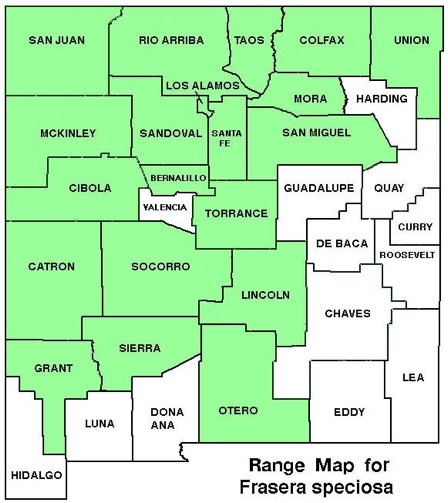WILDFLOWERS OF NEW MEXICO

First this dramatic plant produces a dense basal rosette with 18-inch long leaves, then a single bloom stalk reaching 6-feet tall with an elongated cluster of intricately decorated flowers. In favorable years, hundreds can cover open mountain slopes and meadows. The plant adds leaves to the basal rosette each growing season for years, then blooms once and dies.
FLOWERS: May–September. Plants bloom irregularly, often in mass in following wet years or not at all during stressful years. Dense to open clusters of flowers grow in whorls from the axils of leafy bracts along an unbranching stem, 2–6-foot-tall. Flowers have 4 petals, each 5/8–3/4-inch (15-20 mm) long, elliptic, pointed, white to greenish with purplish spots, 2 nectar pits outlined with hair, and a fringed crown around the base.
LEAVES: Basal leaves 6–18-inches (15-45 cm) long, 1–6-inches (2.5-15) cm wide; stem leaves in whorls of 3–5, reduced upward.
HABITAT: Rich soils of wet mountain meadows, open conifer forests.
ELEVATION: 6,200-10,500 feet.
RANGE: Widespread in mountains of western U. S.
SIMILAR SPECIES: Tufted Elkweed, F. paniculata, in sandy desert soils in western NM, has narrow basal leaves with wrinkled, white margins and a slender, open-branching flower stalk.
NM COUNTIES: Statewide in mountainous habitats: Bernalillo, Catron, Cibola, Colfax, Grant, Lincoln, Los Alamos, McKinley, Mora, Otero, Rio Arriba, San Juan, San Miguel, Sandoval, Santa Fe, Sierra, Socorro, Taos, Torrance, Union.









MONUMENT PLANT, ELKWEED
FRASERA SPECIOSA
Gentian Family, Gentianaceae
Perennial herb


















THE CONTENTS OF THIS WEBSITE ARE COPYRIGHTED AND CANNOT BE USED
WITHOUT PERMISSION OF GEORGE OXFORD MILLER





























































EMAIL ME







